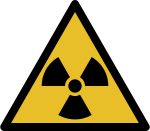Портал ядерных технологий

The possibility of nuclear weapons was acknowledged early in the war. At the University of Birmingham, Rudolf Peierls and Otto Robert Frisch co-wrote a memorandum explaining that a small mass of pure uranium-235 could be used to produce a chain reaction in a bomb with the power of thousands of tons of TNT. This led to the formation of the MAUD Committee, which called for an all-out effort to develop nuclear weapons. Wallace Akers, who oversaw the project, chose the deliberately misleading code name "Tube Alloys". His Tube Alloys Directorate was part of the Department of Scientific and Industrial Research.
The Tube Alloys programme in Britain and Canada was the first nuclear weapons project. Due to the high costs for Britain while fighting a war within bombing range of its enemies, Tube Alloys was ultimately subsumed into the Manhattan Project by the Quebec Agreement with the United States. Under the agreement, the two nations would share nuclear weapons technology, and refrain from using it against each other, or against other countries without mutual consent. However, the United States did not provide complete details of the results of the Manhattan Project to the United Kingdom. The Soviet Union gained valuable information through its atomic spies, who had infiltrated both the British and American projects.
The United States terminated co-operation after the war ended, under the Atomic Energy Act of 1946. That prompted the United Kingdom to relaunch its own project, High Explosive Research. Production facilities were established and British scientists continued their work under the auspices of an independent British programme. In 1952, Britain performed a nuclear test under the codename "Operation Hurricane" and became the third nuclear-weapon state. In 1958, in the wake of the Sputnik crisis, and the British demonstration of a two-stage thermonuclear bomb, the United Kingdom and the United States signed the US–UK Mutual Defence Agreement, which resulted in a resumption of Britain's nuclear Special Relationship with the United States. (Full article...)
During World War I, he served in the U.S. Army, where he worked on the development of poison gases, especially Lewisite. He became an assistant professor of chemistry at Harvard University in 1919 and the Sheldon Emery Professor of Organic Chemistry in 1929. He researched the physical structures of natural products, particularly chlorophyll, and he was one of the first to explore the sometimes complex relationship between chemical equilibrium and the reaction rate of chemical processes. He studied the biochemistry of oxyhemoglobin providing insight into the disease methemoglobinemia, helped to explain the structure of chlorophyll, and contributed important insights that underlie modern theories of acid-base chemistry.
In 1933, Conant became the president of Harvard University with a reformist agenda that involved dispensing with a number of customs, including class rankings and the requirement for Latin classes. He abolished athletic scholarships, and instituted an "up or out" policy, under which untenured faculty who were not promoted were terminated. His egalitarian vision of education required a diversified student body, and he promoted the adoption of the Scholastic Aptitude Test (SAT) and co-educational classes. During his presidency, women were admitted to Harvard Medical School and Harvard Law School for the first time.
Conant was appointed to the National Defense Research Committee (NDRC) in 1940, becoming its chairman in 1941. In this capacity, he oversaw vital wartime research projects, including the development of synthetic rubber and the Manhattan Project, which developed the first atomic bombs. On July 16, 1945, he was among the dignitaries present at the Alamogordo Bombing and Gunnery Range for the Trinity nuclear test, the first detonation of an atomic bomb, and was part of the Interim Committee that advised President Harry S. Truman to use atomic bombs on Japan. After the war, he served on the Joint Research and Development Board (JRDC) that was established to coordinate burgeoning defense research, and on the influential General Advisory Committee (GAC) of the Atomic Energy Commission (AEC); in the latter capacity he advised the president against starting a development program for the hydrogen bomb.
In his later years at Harvard, Conant taught undergraduate courses on the history and philosophy of science, and wrote books explaining the scientific method to laymen. In 1953, he retired as president of Harvard University and became the United States High Commissioner for Germany, overseeing the restoration of German sovereignty after World War II, and then was Ambassador to West Germany until 1957.
On returning to the United States, Conant criticized the education system in The American High School Today (1959), Slums and Suburbs (1961), and The Education of American Teachers (1963). Between 1965 and 1969, Conant authored his autobiography, My Several Lives (1970). He became increasingly infirm, had a series of strokes in 1977, and died in a nursing home in Hanover, New Hampshire, the following year. (Full article...)
Более подробную информацию по этой теме можно найти в следующих родственных проектах Фонда Викимедиа :